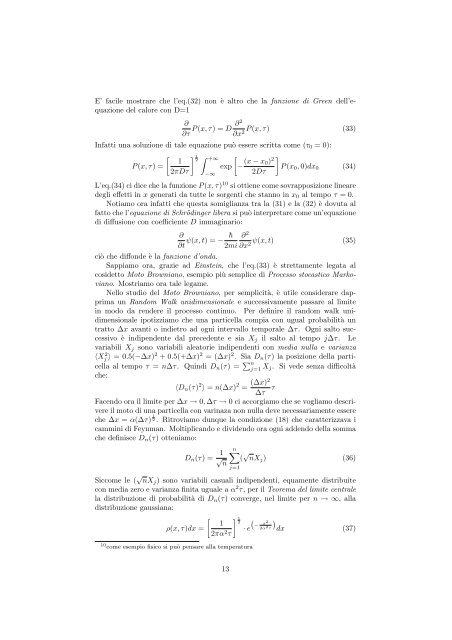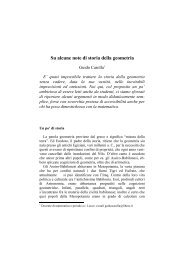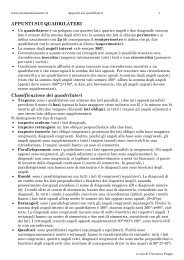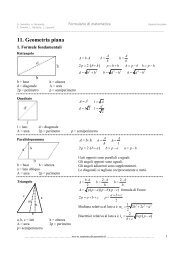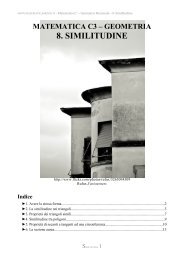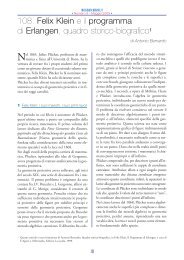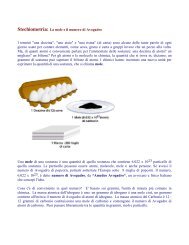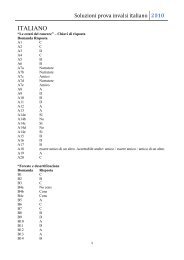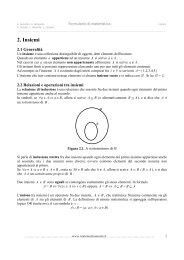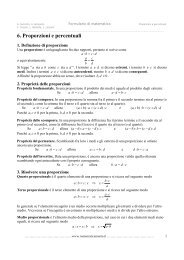Scarica la tesi Integrale di Feynman sui Cammini e Processi Stocastici
Scarica la tesi Integrale di Feynman sui Cammini e Processi Stocastici
Scarica la tesi Integrale di Feynman sui Cammini e Processi Stocastici
You also want an ePaper? Increase the reach of your titles
YUMPU automatically turns print PDFs into web optimized ePapers that Google loves.
E’ facile mostrare che l’eq.(32) non è altro che <strong>la</strong> funzione <strong>di</strong> Green dell’equazione<br />
del calore con D=1<br />
∂<br />
∂τ<br />
∂2<br />
P (x, τ) = D P (x, τ) (33)<br />
∂x2 Infatti una soluzione <strong>di</strong> tale equazione può essere scritta come (τ0 = 0):<br />
1<br />
2 1<br />
P (x, τ) =<br />
2πDτ<br />
+∞ <br />
2 (x − x0)<br />
exp − P (x0, 0)dx0<br />
2Dτ<br />
−∞<br />
(34)<br />
L’eq.(34) ci <strong>di</strong>ce che <strong>la</strong> funzione P (x, τ) 10 si ottiene come sovrapposizione lineare<br />
degli effetti in x generati da tutte le sorgenti che stanno in x0 al tempo τ = 0.<br />
Notiamo ora infatti che questa somiglianza tra <strong>la</strong> (31) e <strong>la</strong> (32) è dovuta al<br />
fatto che l’equazione <strong>di</strong> Schrö<strong>di</strong>nger libera si può interpretare come un’equazione<br />
<strong>di</strong> <strong>di</strong>ffusione con coefficiente D immaginario:<br />
∂<br />
¯h<br />
ψ(x, t) = −<br />
∂t 2mi<br />
∂ 2<br />
ψ(x, t) (35)<br />
∂x2 ciò che <strong>di</strong>ffonde è <strong>la</strong> funzione d’onda.<br />
Sappiamo ora, grazie ad Einstein, che l’eq.(33) è strettamente legata al<br />
cosidetto Moto Browniano, esempio più semplice <strong>di</strong> Processo stocastico Markoviano.<br />
Mostriamo ora tale legame.<br />
Nello stu<strong>di</strong>o del Moto Browniano, per semplicità, è utile considerare dapprima<br />
un Random Walk uni<strong>di</strong>mensionale e successivamente passare al limite<br />
in modo da rendere il processo continuo. Per definire il random walk uni<strong>di</strong>mensionale<br />
ipotizziamo che una particel<strong>la</strong> compia con ugual probabilità un<br />
tratto ∆x avanti o in<strong>di</strong>etro ad ogni intervallo temporale ∆τ. Ogni salto successivo<br />
è in<strong>di</strong>pendente dal precedente e sia Xj il salto al tempo j∆τ. Le<br />
variabili Xj sono variabili aleatorie in<strong>di</strong>pendenti con me<strong>di</strong>a nul<strong>la</strong> e varianza<br />
〈X2 j 〉 = 0.5(−∆x)2 + 0.5(+∆x) 2 = (∆x) 2 . Sia Dn(τ) <strong>la</strong> posizione del<strong>la</strong> particel<strong>la</strong><br />
al tempo τ = n∆τ. Quin<strong>di</strong> Dn(τ) = n j=1 Xj. Si vede senza <strong>di</strong>fficoltà<br />
che:<br />
〈Dn(τ) 2 〉 = n(∆x) 2 = (∆x)2<br />
∆τ τ<br />
Facendo ora il limite per ∆x → 0, ∆τ → 0 ci accorgiamo che se vogliamo descri-<br />
vere il moto <strong>di</strong> una particel<strong>la</strong> con varinaza non nul<strong>la</strong> deve necessariamente essere<br />
che ∆x = α(∆τ) 1<br />
2 . Ritroviamo dunque <strong>la</strong> con<strong>di</strong>zione (18) che caratterizzava i<br />
cammini <strong>di</strong> <strong>Feynman</strong>. Moltiplicando e <strong>di</strong>videndo ora ogni addendo del<strong>la</strong> somma<br />
che definisce Dn(τ) otteniamo:<br />
Dn(τ) = 1<br />
√ n<br />
n<br />
( √ nXj) (36)<br />
Siccome le ( √ nXj) sono variabili casuali in<strong>di</strong>pendenti, equamente <strong>di</strong>stribuite<br />
con me<strong>di</strong>a zero e varianza finita uguale a α2τ, per il Teorema del limite centrale<br />
<strong>la</strong> <strong>di</strong>stribuzione <strong>di</strong> probabilità <strong>di</strong> Dn(τ) converge, nel limite per n → ∞, al<strong>la</strong><br />
<strong>di</strong>stribuzione gaussiana:<br />
<br />
1<br />
ρ(x, τ)dx =<br />
2πα2τ j=1<br />
10 come esempio fisico si può pensare al<strong>la</strong> temperatura<br />
13<br />
1 2<br />
x −<br />
· e<br />
2<br />
2α2 <br />
τ dx (37)


